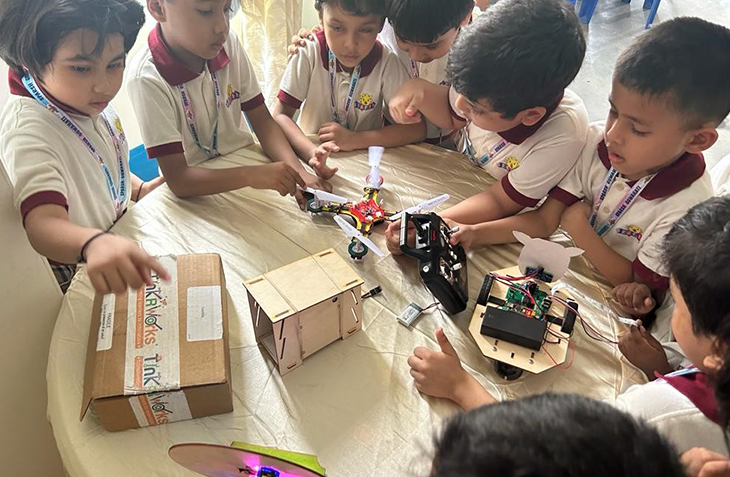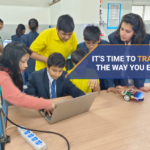It’s the 21st century and robots are evolving faster than humans. From industries to restaurants, we are seeing robots emerge everywhere and they’re becoming more personalised and advanced with each passing day.
Imagine a decade from now when the aspired careers of today will find no recognition and the job market will be hunting for professionals whose primary job will be to handle a robot. What will then be the most in-demand skill? Robotics and AI for sure. While it may seem too far-fetched today the landscape is evolving rapidly, and this reality will knock on your door sooner than you know.
The government too realised the pressing need to revolutionise the Indian education system so to stay relevant and abreast of the changing environment, they launched a more holistic and dynamic approach towards K-12 learning through the National Education Policy (NEP) in 2020.
Under the NEP 2020, a crucial focus is laid on a more holistic approach towards education. This objective is achieved by integrating more enjoyable, and engaging learning experiences in the curriculum and pedagogy. These learning experiences are closely bound with an emphasis on early STEM education schools which foster critical thinking and promote problem-solving attitudes.
Another major initiative taken in the NEP 2020, brought along with itself the encouragement of tinkering labs in schools to teach and build the knowledge of robotics in K-12 students. The introduction of these labs has been instrumental, but first, let’s discover the key benefits of including robotics and artificial intelligence courses in K-12 learning:
Promotes Critical Thinking and Creativity
Robotics and artificial intelligence courses brush up the student’s computational thinking. Computational thinking is the process of logical problem-solving within a variety of technology-enhanced contexts.
The robotics and artificial intelligence courses for K-12 aren’t just about tightening the screw of a model or coding in a computer, it often involves overcoming challenges that require a deep understanding of the problem. Students actively generate ideas and formulate solutions based on problem statements. This process cultivates a mindset that chisels their complex problem-solving skills and builds a methodical approach to overcoming challenges.
Encourages Teamwork and Communication
The biggest nightmare of a K-12 student is their exams and grades. But, for a practically driven subject like robotics, teachers grade students on less tangible things than examination grades. They are assessed based on qualities like teamwork, communication, contribution, and overall determination to find solutions through rigorous, analytical thinking. By working in teams on a shared goal, they explore learning beyond the classroom and the blackboard, gaining understanding while having fun.
Fosters a Greater Design Sense
Through hand-held projects, students have the creative liberty to develop robots and models which help them form and create the pieces of their imagination. On a more academic level, students can learn computer-assisted design (CAD) software which will give them a sense of how to stimulate robot activity.
Imparts Higher-Order Learning
Where an average student is always struggling to perform better in math and science, robotics and artificial intelligence courses facilitate higher-order learning in math and science within their fun and practical realm. Higher-order learning involves complex cognitive processes such as critical thinking, analysis, synthesis, and evaluation. These skills are essential for problem-solving and are effectively cultivated through the challenges and tasks involved in robotics.
Many schools across India have integrated robotics and Tinkering Labs and they have shared many positive outcomes from the K-12 student learning journey. The outcomes include increased student engagement, enhanced problem-solving skills, and equaAlised opportunities for all students regardless of their backgrounds. The Tinkering Labs provide a stimulative and innovative learning environment in the following ways:
- Learning Programs: Students are taught and explained key robotics concepts every month. These exciting concepts range from ideation, design, prototyping, and networking to physical computing.
- Competitions: Students get a chance to participate in regional and national level competitions to showcase their skills on a larger platform.
- Exhibitions/Fairs/Carnivals: Events are organised periodically for students to showcase their innovative creations.
- Workshops: Workshops on problem-solving, designing, and fabrication of products are conducted. These help students with better hands-on learning.
- Lecture Series: Industry experts come and interact with students by sharing their knowledge and experiences to help them understand better.
In a nutshell, incorporating robotics and artificial intelligence courses is an investment towards preparing students with essential 21st-century skills, getting them ready for a future driven by technology. This impactful addition helps to enhance critical thinking, innovation, and problem-solving, perfectly in line with NEP 2020’s forward-thinking framework.
Dr. Ritu Uppal is the chief academics officer at Get Set Learn, an Arvind Mafatlal Group Company.









